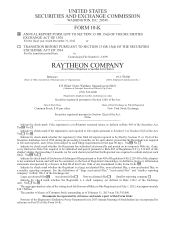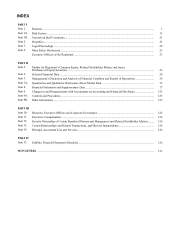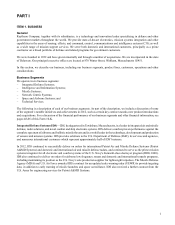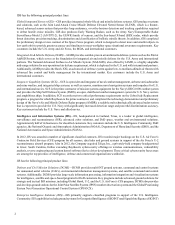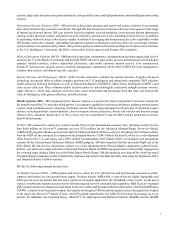Raytheon 2012 Annual Report Download - page 17
Download and view the complete annual report
Please find page 17 of the 2012 Raytheon annual report below. You can navigate through the pages in the report by either clicking on the pages listed below, or by using the keyword search tool below to find specific information within the annual report.9
contractor is generally entitled to payments for its allowable costs and will receive some allowance for profit on the work
performed. If a contract is terminated for default, the contractor is generally entitled to payments for its work that has been
accepted by the government. The U.S. Government's right to terminate its contracts has not had a material adverse effect upon
our operations or financial condition. For a discussion of the risks associated with the U.S. Government's right to terminate
its contracts, see Item 1A “Risk Factors” of this Form 10-K.
U.S. Government programs generally are implemented by the award of individual contracts and subcontracts. Congress
generally appropriates funds on a fiscal year basis even though a program may extend across several fiscal years. Consequently,
programs are often only partially funded initially and additional funds are committed only as Congress makes further
appropriations. The contracts and subcontracts under a program generally are subject to termination for convenience or
adjustment if appropriations for such programs are not available or change. The U.S. Government is required to equitably
adjust a contract price for additions or reductions in scope or other changes ordered by it. For a discussion of the risks associated
with program funding and appropriations, see Item 1A “Risk Factors” and “Overview” within Item 7 of this Form 10-K. In
addition, because we are engaged in supplying technologically-advanced, cutting edge defense-related products and services
to the U.S. Government, we are subject to certain business risks, some of which are specific to our industry. These risks
include: the cost of obtaining and retaining trained and skilled employees; the uncertainty and instability of prices for raw
materials and supplies; the problems associated with advanced designs, which may result in unforeseen technological
difficulties and cost overruns; and the intense competition and the constant necessity for improvement in facility utilization
and personnel training. Our sales to the U.S. Government may be affected by changes in procurement policies, budget
considerations, changing priorities for national defense, political developments abroad and other factors. See Item 1A “Risk
Factors” and “Overview” within Item 7 of this Form 10-K for a more detailed discussion of these and other related risks.
We are also involved in U.S. Government programs, principally through our IIS and SAS business segments, that are classified
by the U.S. Government and cannot be specifically described in this Form 10-K. The operating results of these classified
programs are included in the applicable business segment's and our consolidated results of operations. The business risks and
considerations associated with these and our international classified programs generally do not differ materially from those
of our other programs and products. Total classified sales were 16%, 16% and 14% of total net sales in 2012, 2011 and 2010,
respectively.
We are subject to government regulations and contract requirements that may differ from U.S. Government regulation with
respect to our sales to non-U.S. customers. See “International Sales” below for more information regarding our sales outside
of the U.S. and Item 1A “Risk Factors” for a discussion of the risks associated with international sales.
See “Sales to the U.S. Government” on page 7 of this Form 10-K for information regarding the percentage of our revenues
generated from sales to the U.S. Government.
International Sales
Our sales to customers outside the U.S., including foreign military sales through the U.S. Government, were $6.2 billion or
26% of total net sales in 2012, $6.1 billion or 25% of total net sales in 2011, and $5.8 billion or 23% of total net sales in 2010.
Foreign military sales through the U.S. Government were $3.2 billion, $3.0 billion and $3.3 billion, in 2012, 2011 and 2010,
respectively. International sales were principally in the areas of air and missile defense systems, missile systems, airborne
radars, naval systems, air traffic control systems, electronic equipment, computer software and systems, personnel training,
equipment maintenance and microwave communications technology, and other products and services permitted under the
International Traffic in Arms Regulations (ITAR). Generally, we finance our foreign subsidiary working capital requirements
in the applicable countries. Sales and income from international operations and investments are subject to U.S. Government
laws, regulations and policies, including the ITAR and the Foreign Corrupt Practices Act (FCPA) and the export laws and
regulations described below, as well as foreign government laws, regulations and procurement policies and practices, which
may differ from U.S. Government regulation, including import-export control, investments, exchange controls, repatriation
of earnings and requirements to expend a portion of program funds in-country. In addition, embargoes, international hostilities
and changes in currency values can also impact our international sales. Exchange restrictions imposed by various countries
could restrict the transfer of funds between countries and between Raytheon and its subsidiaries. We have acted to protect
ourselves against various risks through insurance, foreign exchange contracts, contract provisions, government guarantees
and/or progress payments. See revenues derived from external customers and long-lived assets by geographical area set forth
in “Note 16: Business Segment Reporting” within Item 8 of this Form 10-K.


